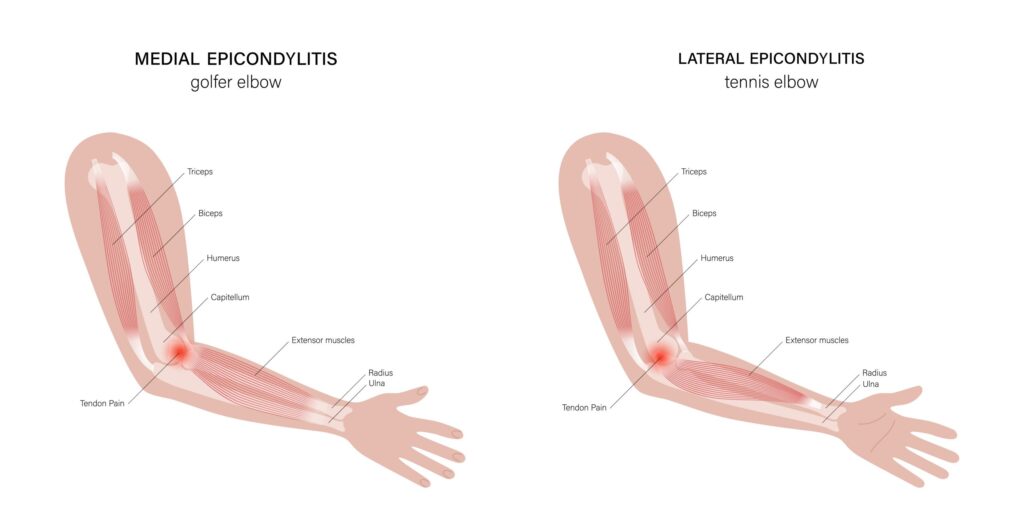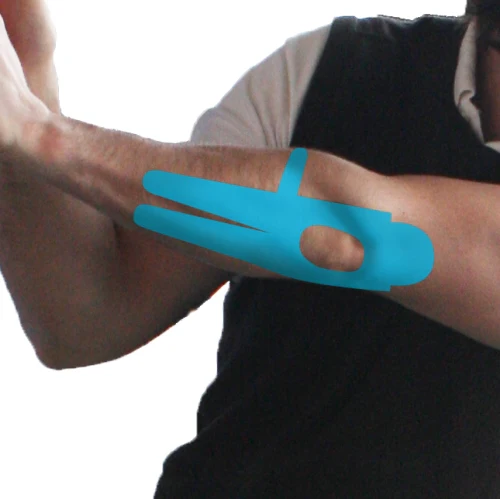Addressing Tennis and Golfer’s Elbow
Tennis elbow (lateral epicondylitis) and golfer’s elbow (medial epicondylitis) are prevalent overuse injuries causing elbow pain and restricting activities such as gripping, lifting, or twisting. Tennis elbow is characterised by discomfort on the outer elbow, stemming from overworked forearm muscles used in gripping, wrist extension, and elbow extension. Golfer’s elbow presents as pain on the inner elbow, resulting from overuse of muscles involved in gripping, wrist flexion, and elbow flexion. Limited blood supply to the affected tendons slows healing, prolonging symptoms. At Elite Performance Therapy, we offer specialised sports therapy to relieve pain, promote tissue recovery, and restore full elbow functionality.

Sources of Elbow Discomfort
Tennis elbow (lateral epicondylitis) and golfer’s elbow (medial epicondylitis) typically arise from repetitive strain or overuse. Examples may include :
- Sporting Activities: Tennis, golf, or racket sports overload forearm muscles and tendons.
- Repetitive Tasks: Manual activities like gardening, painting, or lifting strain the elbow.
- Prolonged Computer Use: Extensive mouse or keyboard use causes repetitive wrist and elbow stress.
- Improper Technique: Poor form in sports or tasks increases tendon strain.
- Muscle Imbalances: Weak or tight forearm muscles elevate injury risk.
Symptoms encompass elbow pain (outer for tennis elbow, inner for golfer’s elbow) radiating to the wrist, pain during lifting, gripping, or twisting (e.g., opening doors), wrist weakness, difficulty extending the arm, and occasional swelling. If untreated, these impair daily function.
Initial Management Strategies
Early intervention can alleviate pain and support healing. Recommended strategies include:
- Activity Modification: Avoid repetitive gripping or lifting to reduce tendon stress.
- Icing: Apply ice packs to the elbow for 15 minutes every 2–3 hours to ease inflammation.
- Bracing: Use a counterforce brace to offload tendon strain during activity.
- Pain Relief: Take over-the-counter anti-inflammatory medications, such as ibuprofen, for discomfort (always consult a doctor first).
Treatment Approaches
At Elite Performance Therapy, we combine techniques to reduce pain, stimulate tissue repair, and restore full range of motion. Treatments may include:
- Sports Massage: A key therapy, sports massage targets forearm and elbow muscles, relieving tension, reducing pain, and enhancing circulation to promote healing and flexibility.
- Trigger Point Therapy: Focused techniques address tight spots in the forearm, alleviating pain and improving movement, often providing immediate relief.
- Deep Muscle Therapy: Deeper massage relieves chronic tension in the forearm and elbow, supporting tendon recovery and reducing inflammation.
- Dry Needling: Fine needles inserted into trigger points release tension, reduce pain, and enhance blood flow, aiding tendon healing.
- Proprioceptive Neuromuscular Facilitation (PNF) Stretching: PNF stretching improves forearm flexibility and strength, reducing tendon strain through controlled contractions and stretches.
- Rehabilitation Exercises: Personalised exercises strengthen and stretch the forearm, enhancing stability and preventing re-injury. Specific exercises include:
- Wrist Flexor Stretch: Extend one arm, pull the fingers back with the other hand, hold for 20 seconds, and repeat 10 times per side to lengthen flexor muscles and ease golfer’s elbow pain.
- Wrist Extensor Stretch: Extend one arm, pull the fingers down with the other hand, hold for 20 seconds, and repeat 10 times per side to relieve tennis elbow tension.
- Kinesiology Taping: Supportive taping or bracing stabilises the elbow, reduces tendon stress, and promotes healing during activity.
- Future Shockwave Therapy: We are excited to announce that, coming soon, we will offer shockwave therapy as an innovative modality for tennis and golfer’s elbow. This non-invasive treatment uses acoustic waves to stimulate healing, reduce pain, and enhance tissue repair, providing a cutting-edge option for faster recovery.

Preventing Recurrence
Preventing recurrence of tennis and golfer’s elbow requires habits to maintain elbow health:
- Ongoing Exercise: Regular forearm exercises to enhance strength and flexibility.
- Proper Technique: Use correct form in sports and tasks to minimise strain.
- Ergonomic Adjustments: Optimise workstations to reduce repetitive stress.
- Activity Moderation: Avoid overusing the elbow in repetitive tasks.
- Stretching Routine: Stretch forearms daily to prevent tightness.

Curious to find out more or ready to begin with a complimentary initial chat? 😊 Contact us here to schedule your appointment and embark on your journey to pain-free elbows!
